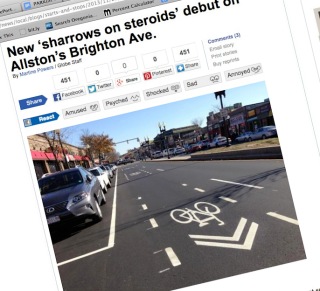
(Screenshot from Boston Globe)
The latest twist in America’s effort to retrofit our auto-oriented infrastructure so that it’s suitable for cycling comes from Boston. That city hs deployed what’s being called “super sharrows” or “sharrows on steroids.” Here’s a blurb about them from a story published in the Boston Globe on Wednesday:
I first noticed the markings last week while driving through Allston Village. Running down the right-hand lanes on both sides of Brighton Avenue are bike-priority icons, known as “sharrows” in cyclist parlance, hugged by two sets of dashed lines along either side that make the lane look more like an airport runway.
My first thought: Sharrows on steroids!
And Boston bike czar Nicole Freedman said that’s exactly what they are. (Well, except that the former Olympic cyclist wasn’t too happy about the doping analogy.) Officially, the markings have a more dignified name: Priority shared-lane markings.
That story in the Globe was sort of fascinating to me for a few reasons; mostly having to do with “Boston bike czar” Nicole Freedman (not sure why, but she’s often given that title). I couldn’t help but notice the irony of how a new and improved sharrow marking — a marking that has many detractors for its appeal to the “strong and fearless” while doing nothing for the “8-80” crowd American cities must do a better job attracting — is being pioneered by someone with an Olympic cycling pedigree. That seems fitting in a country where we still haven’t been able to shed our performance-oriented mindset to urban cycling.
Another thing that stood out to me about this story is the rationale Freedman gave for her experimentation with this new type of sharrow marking:
“We could not remove a lane to put in a bike lane, and we could not remove parking — that’s a fact,” Freedman said. “We said, this is such an important part of the network — can we do better than standard sharrows?”
Maybe it’s just me; but I was disappointed to see this statement coming from the “bike czar” of a silver-rated bicycle-friendly city. It’s very telling about the state of cycling in America that a major city bike planner is unable to challenge the auto-dominated infrastructure status quo — even on a street that is “an important part of the network.”
According to the 2009 research by Peter Furth (PDF) that these new markings are partly based on, these sharrows can “help provide the ‘feel’ of a bike lane — even if there’s no room for one.”
Seems to me there’s plenty of room for a real cycle path, it’s just that no one is willing to use it.
Freedman’s acceptance of cycling infrastructure as an afterthought is something echoed here in Portland. When PBOT approaches street projects that include a major bicycle infrastructure component, it’s often made clear at the outset of the planning process that removing auto parking will be “a big lift” or a “significant trade-off for businesses” or worse yet, that it’s not even an option.
When I first learned about sharrows in 2005 (Portland was one of the first cities to use them), they seemed like a great way to create the perception of bike space on streets without bike lanes. But that was eight years ago! Isn’t it time we move beyond paint and perceptions and into creating streets where people on bicycles can expect the same level of comfort and access that we give to people’s cars? We get what we design for.
Sharrows are controversial because there’s a growing number of Americans who are no longer satisfied with the lack of respectful bike infrastructure in our cities. They want something more robust, connected, and protected. “Super sharrows” are not going to move the needle of cycling participation in America. Worse yet, they’ll be lauded by city engineers, planners and advocates as incremental improvements (a.k.a. “progress”) which will only serve to dial back the sense of urgency so badly needed to push for real solutions.
Just like steroids, when used incorrectly, sharrows are a dangerous shortcut en route to a healthy system.
Thankfully here in Portland, our bike planners aren’t looking to expand our use of sharrows. This is partly because PBOT decided to use sharrows on our “family-friendly, low stress” neighborhood greenways as wayfinding devices. If PBOT now places the same sharrow markings on a busy street in between a door zone and a lane of 35 mph (or more) auto traffic, they’re worried people will have similar expectations.
At this point, Boston is only doing an experiment with the FHWA on these markings to see if they work and if they should be more widely adopted. We’ll let you know how it turns out.
In the meantime, we’d love to hear what you think.

